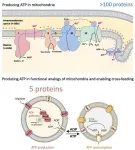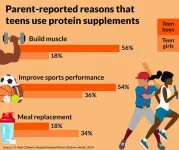(Press-News.org) Guideline Highlights:
Each year in the U.S., over half a million people have a first stroke; however, up to 80% of strokes may be preventable.
The new primary prevention of stroke guideline from the American Stroke Association urges health care professionals to screen people for stroke risk factors, including high blood pressure, elevated cholesterol, high blood sugar and obesity.
Increasing public awareness and knowledge about healthy lifestyle changes, such as smoking cessation, increased physical activity, improved dietary habits and better sleep, may also help people reduce their stroke risk.
The new guideline highlights the American Heart Association’s Life’s Essential 8 health metrics for optimal cardiovascular and brain health, medications for risk factor management, risks specific to women and ways to address social determinants of health.
Embargoed until 4:00 a.m. CT/5:00 a.m. ET Monday, Oct. 21, 2024
DALLAS, Oct. 21, 2024 — Healthy lifestyle behaviors, such as good nutrition, smoking cessation and being physically active, along with routine health screenings and managing risk factors for cardiovascular disease and stroke with medication, can help prevent individuals from having a first stroke. Screening for stroke risk and educating people on how to lower their chances of having a stroke ideally begin with their primary care professional and include evidence-based recommendations, according to a new clinical guideline from the American Stroke Association, a division of the American Heart Association, and published today in the Association’s journal Stroke.
A stroke occurs when blood flow to the brain is interrupted after a blood vessel becomes blocked by a blood clot or ruptures. The result is the brain does not receive the oxygen it needs to properly function. Stroke causes brain damage that can lead to significant disability, including difficulty thinking, talking, walking and interacting with one’s environment. In the U.S., stroke is currently the fifth leading cause of death, resulting in nearly 160,000 deaths annually. Every year, more than 600,000 people in the U.S. have a first stroke, even though up to 80% of strokes are preventable.
“The most effective way to reduce the occurrence of a stroke and stroke-related death is to prevent the first stroke—referred to as primary prevention,” said Chair of the guideline writing group, Cheryl D. Bushnell, M.D., M.H.S., FAHA, professor and vice chair of research in the department of neurology at Wake Forest University School of Medicine in Winston-Salem, North Carolina. “Some populations have an elevated risk of stroke, whether it be due to genetics, lifestyle, biological factors and/or social determinants of health, and in some cases, people do not receive appropriate screening to identify their risk.”
The “2024 Guideline for the Primary Prevention of Stroke” replaces the 2014 version and is a resource for clinicians in implementing a variety of prevention strategies for individuals with no prior history of stroke. The new guideline provides evidence-based recommendations for strategies to support brain health and prevent stroke throughout a person’s lifespan by improving healthy lifestyle behaviors and getting preventive care.
“This guideline is important because new discoveries have been made since the last update 10 years ago. Understanding which people are at increased risk of a first stroke and providing support to preserve heart and brain health can help prevent a first stroke,” said Bushnell.
Key stroke prevention recommendations include regular health screenings, identifying risk factors, lifestyle interventions and medications, when indicated.
Identifying and Managing Risk Factors
Unidentified and unmanaged cardiovascular disease risk factors can cause damage to arteries, the brain and the heart years before cardiovascular disease and stroke occur. Primary care health professionals should promote brain health for patients through stroke prevention education, screenings and addressing risk factors from birth to old age.
Modifiable risk factors for stroke, such as high blood pressure, overweight and obesity, elevated cholesterol and elevated blood sugar, can be identified with physical exams and blood tests. These conditions should be addressed with healthy lifestyle and behavioral changes and may include medications for select patients. Antihypertensive medications to reduce blood pressure and statin medications to lower cholesterol can help to reduce the risk of first stroke in adults with increased cardiovascular disease risk and those receiving CVD care. A new recommendation is consideration of glucagon-like protein-1 (GLP-1) receptor agonist medications, which are FDA-approved to reduce the risk of cardiovascular disease in people with overweight or obesity and/or Type 2 diabetes.
Healthy Lifestyle Behaviors
The most common, treatable lifestyle behaviors that can help reduce stroke risk are detailed in the Association’s Life’s Essential 8 cardiovascular health metrics. They include healthy nutrition, regular physical activity, avoiding tobacco, healthy sleep and weight, controlling cholesterol, and managing blood pressure and blood sugar. The guideline recommends that adults with no prior cardiovascular disease, as well as those with increased risk, follow a Mediterranean dietary pattern. Mediterranean dietary programs have been shown to reduce the risk of stroke, especially when supplemented with nuts and olive oil.
Physical activity is also essential for stroke risk reduction and overall heart health. Physical activity can help to improve important health measures such as blood pressure, cholesterol, inflammatory markers, insulin resistance, endothelial function and weight. The guideline urges health care professionals to routinely screen patients for sedentary behavior, a confirmed risk factor for stroke, and counsel them to engage in regular physical activity. The Association reinforces the U.S. Department of Health and Human Services Office of Disease Prevention and Health Promotion’s recommendation that adults get at least 150 minutes per week of moderate-intensity aerobic activity or 75 minutes per week of vigorous aerobic activity, or a combination of both, preferably spread throughout the week.
Health Equity and Stroke Risk
New to the guideline is an emphasis on social determinants of health and the impact they have on stroke risk. Social determinants of health are non-medical factors, including education, economic stability, access to care, discrimination, structural racism and neighborhood factors (such as the lack of walkability, lower availability of healthy food and fewer health resources), that contribute to inequities in care and influence overall health. Health care professionals should ensure patient education is available for various educational and language levels, and advocate for their patients by choosing treatments and medications that are effective and affordable.
Health care professionals are also encouraged to connect patients to resources that help address health-related social needs such as food and housing insecurity, refer them to programs that support healthy lifestyle changes and direct them to support programs that may help defray health care costs including medication expenses.
New Sex- and Gender-Specific Recommendations
The guideline also includes some new gender- and sex-specific recommendations for women. Health professionals should screen for conditions that can increase a woman’s risk of stroke, including use of oral contraceptives, high blood pressure during pregnancy, other pregnancy complications such as premature birth, endometriosis, premature ovarian failure and early onset menopause. Treatment of elevated blood pressure during pregnancy and within six weeks of delivery is recommended to reduce the risk of maternal intracerebral hemorrhage.
Transgender women and gender-diverse individuals taking estrogens for gender affirmation may also be at an increased risk of stroke. Evaluation and modification of any existing risk factors are needed to reduce the risk of stroke for these individuals.
“Implementing the recommendations in this guideline would make it possible to significantly reduce the risk of people having a first stroke. Most strategies that we recommend for preventing stroke will also help reduce the risk of dementia, another serious health condition related to vascular issues in the brain,” said Bushnell.
The writing group notes that writing recommendations focused on preventing a first stroke was challenging. There are limitations to some of the evidence that informed the guideline, including that many clinical trials enrolled adults who have already had a cardiovascular event that may include a stroke. The writing group also identified knowledge gaps to help inform topics for future research.
The guideline highlights the need for risk assessment in primary stroke prevention and includes the use of risk prediction tools to estimate risk for atherosclerotic cardiovascular disease so that patients receive timely prevention and treatment strategies. The Association has recently developed a new Predicting Risk of Cardiovascular Disease Events (PREVENT) risk calculator as a screening tool that can help inform preventive treatment decisions. The PREVENT calculator can estimate 10-year and 30-year stroke and heart disease risk in individuals starting at age 30—a decade earlier than the Pooled Cohort Equations, another CVD risk calculator.
According to the American Stroke Association, learning the warning signs of stroke and preventative measures are the best way to avoid strokes and keep them from happening again. The abbreviation F.A.S.T. — for face drooping, arm weakness, speech difficulty, time to call 911 — is a useful tool to recognize the warning signs of stroke and when to call for help.
This guideline was prepared by the volunteer writing group on behalf of the American Stroke Association and is endorsed by the Preventive Cardiovascular Nurses Association and the Society for Vascular Surgery. The American College of Obstetricians and Gynecologists supports the clinical value of this document as an educational tool.
Since 1990, the American Stroke Association has translated scientific evidence into clinical practice guidelines with recommendations to improve cerebrovascular health. The “2024 Guideline for the Primary Prevention of Stroke” replaces the 2014 “Guidelines for the Primary Prevention of Stroke.” This updated guideline is intended to be a resource for clinicians to use to guide various prevention strategies for individuals with no history of stroke. The Association supports the development and publication of clinical practice guidelines without commercial support, and members volunteer their time to the writing and review efforts.
Co-Vice Chairs of the volunteer writing group are Walter N. Kernan, M.D., and Anjail Z. Sharrief, M.D., M.P.H., FAHA. Co-authors and members of the writing group are Seemant Chaturvedi, M.D.; John W. Cole, M.D., M.S.; William K. Cornwell III, M.D., M.S.C.S., FAHA; Christine Cosby-Gaither, Ed.D.; Sarah Doyle, M.D.; Larry B. Goldstein, M.D., FAHA; Olive Lennon, Ph.D.; Deborah A. Levine, M.D., M.P.H.; Mary Love, Ph.D., R.N.; Eliza Miller, M.D., M.S.; Mai Nguyen-Huynh, M.D., M.A.S., FAHA; Jennifer Rasmussen-Winkler, M.D., FAHA; Kathryn M. Rexrode, M.D., M.P.H., FAHA; Nicole Rosendale, M.D.; Satyam Sarma, M.D.; Daichi Shimbo, M.D.; Alexis N. Simpkins, M.D., Ph.D., M.S.C.R., FAHA; Erica S. Spatz, M.D., M.H.S.; Lisa R. Sun, M.D.; Vin Tangpricha, M.D., Ph.D.; Dawn Turnage; Gabriela Velazquez, M.D.; and Paul Whelton, M.B., M.D., M.Sc. Authors’ disclosures are listed in the manuscript.
The Association receives funding primarily from individuals. Foundations and corporations (including pharmaceutical, device manufacturers and other companies) also make donations and fund specific Association programs and events. The Association has strict policies to prevent these relationships from influencing the science content. Revenues from pharmaceutical and biotech companies, device manufacturers and health insurance providers, and the Association’s overall financial information are available here.
Additional Resources:
Available multimedia is on right column of release link https://newsroom.heart.org/news/new-guideline-preventing-a-first-stroke-may-be-possible-with-screening-lifestyle-changes?preview=080c2836686c35208523175fbad33c1e
After October 21, 2024, view the manuscript online.
ASA health information: World Stroke Day is October 29
ASA news release: New Spanish language stroke prevention website aims to remove barriers to equitable health (Sept. 2024)
ASA news release: 3 ways to protect your heart and brain this American Stroke Month (May 2024)
ASA health information: About Stroke
ASA health information: Stroke Symptoms and Warning Signs
Follow AHA/ASA news on X @HeartNews
Follow news from Stroke, the ASA/AHA journal, @StrokeAHA_ASA
###
About the American Stroke Association
The American Stroke Association is a relentless force for a world with fewer strokes and longer, healthier lives. We team with millions of volunteers and donors to ensure equitable health and stroke care in all communities. We work to prevent, treat and beat stroke by funding innovative research, fighting for the public’s health, and providing lifesaving resources. The Dallas-based association was created in 1998 as a division of the American Heart Association. To learn more or to get involved, call 1-888-4STROKE or visit stroke.org. Follow us on Facebook and X.
END
New guideline: Preventing a first stroke may be possible with screening, lifestyle changes
Updated clinical recommendations, including lifestyle changes, prevention strategies and treatment options, to reduce the risk of a first stroke outlined in a new guideline from the American Stroke Association
2024-10-21
ELSE PRESS RELEASES FROM THIS DATE:
Creating a simplified form of life
2024-10-21
It is one of the most fundamental questions in science: how can lifeless molecules come together to form a living cell? Bert Poolman, Professor of Biochemistry at the University of Groningen, has been working on this problem for over twenty years. He aims to understand life by trying to reconstruct it; he is building simplified artificial versions of biological systems that can be used as components for a synthetic cell. Poolman recently published two papers in Nature Nanotechnology and Nature Communications. In the first paper, he describes a system for energy conversion ...
Large-scale study of brain volume finds genetic links to Parkinson’s disease and ADHD
2024-10-21
In one of the largest-ever studies of DNA and brain volume, researchers have identified 254 genetic variants that shape key structures in the “deep brain,” including those that control memory, motor skills, addictive behaviors and more. The findings were just published in the journal Nature Genetics.
The study is powered by the Enhancing Neuro Imaging Genetics through Meta-Analysis (ENIGMA) consortium, an international effort based at the Keck School of Medicine of USC, which unites more than 1,000 research labs across 45 countries to hunt for genetic variations that affect the brain’s structure and function.
“A lot of brain diseases are known to be partially ...
Understanding the relationship between food waste, climate change, and aging population
2024-10-21
Food production is one of the pillars of human civilization and underlies many of the changes caused by humans on planet’s landscapes. Producing food and getting it to people’s plates entails a significant expenditure of energy and resources. Unfortunately, approximately one third of all food produced globally is not consumed and discarded. Hence, to build sustainable societies, it is essential to minimize food waste.
In Japan, based on estimates reported by governmental institutions, an astonishing 2.47 megatons of food waste was generated in ...
Can aerobic exercise help prevent brain fog caused by chemotherapy?
2024-10-21
Many women who receive chemotherapy experience a decreased ability to remember, concentrate, and/or think—commonly referred to as “chemo-brain” or “brain fog”—both short- and long-term. In a recent clinical trial of women initiating chemotherapy for breast cancer, those who simultaneously started an aerobic exercise program self-reported greater improvements in cognitive function and quality of life compared with those receiving standard care. The findings are published by Wiley online in CANCER, a peer-reviewed journal of the American Cancer Society.
The study, called the Aerobic exercise and ...
National poll: Many teens use protein supplements for muscle growth, sports performance
2024-10-21
ANN ARBOR, Mich. – Protein bars, shakes and powders are increasingly popular among adults – but many teens may be jumping on the bandwagon too.
Two in five parents say their teen consumed protein supplements in the past year, according to the University of Michigan Health C.S. Mott Children’s Hospital National Poll on Children’s Health. The trend was more common among teen boys who were also more likely to take protein supplements every day or most days, parents reported.
“Protein is part of a healthy diet but it can be hard for parents to tell if ...
Dr. Stephanie Knatz Peck: Revolutionizing eating disorder treatment with psychedelic research
2024-10-21
SAN DIEGO, California, 21 October 2024. In an illuminating Genomic Press Interview published today, Dr. Stephanie Knatz Peck, Associate Clinical Professor of Psychiatry at the University of California, San Diego (UCSD), unveils her groundbreaking work in eating disorder treatment and psychedelic research. The interview, featured in the journal Psychedelics, offers an intimate look at Dr. Knatz Peck's journey from personal struggle with an eating disorder to becoming a leading innovator in the field.
Dr. Knatz Peck's research ...
Male flies with shorter eyestalks make up for being less attractive by fighting more fiercely
2024-10-21
In stalk-eyed flies, longer eyestalks attract the ladies. Females prefer males with longer eyestalks, and other males are less likely to fight them for access to females. But some males have a copy of the X chromosome which always causes short eyestalks. Scientists investigating why this mutation hasn’t died out, despite sexual selection, have discovered that the flies could be compensating for their shorter eyestalks with increased aggression.
“It's the first time I'm aware of that there's ...
Light-AI technology opens the door to early cancer diagnosis
2024-10-21
A research team led by Dr. Ho Sang Jung of the Advanced Bio and Healthcare Materials Research Division at the Korea Institute of Materials Science has developed an innovative sensor material that amplifies the optical signals of cancer metabolites in body fluids (saliva, mucus, urine, etc.) and analyzes them using artificial intelligence to diagnose cancer.
This technology quickly and sensitively detects metabolites and changes in cancer patients' body fluids, providing a non-invasive way to diagnose cancer instead of traditional blood draws or biopsies. In collaboration with Professor Soo Woong ...
Need for Inuit-specific growth curves for accurate diagnosis and treatment
2024-10-21
Inuit children in Nunavut, Canada, are being overdiagnosed for macrocephaly and underdiagnosed for microcephaly, two neurological conditions measured by head size, because of reliance on World Health Organization (WHO) growth curves, according to new research in CMAJ (Canadian Medical Association Journal) https://www.cmaj.ca/lookup/doi/10.1503/cmaj.230905.
“Clinicians must be able to identify children with potential medical issues appropriately, without underdiagnosis or overdiagnosis at the extremes of head circumference measurements,” writes Dr. Kristina Joyal, a pediatric neurologist, University of Manitoba and University of Saskatchewan, ...
Majority of UK public expect universities to solve climate change, poll reveals
2024-10-20
New poll shows nearly two-thirds of adults (61%) expect global research universities, such as the University of Cambridge, to come up with new innovations that will help to reduce the effects of climate change.
Alternative fuels for cars and planes, improved batteries and capturing more carbon will have the greatest impact on climate change, the UK public believe.
Respondents want the government to listen to universities when making climate policy, ahead of all other interest groups tested.
Cambridge University is playing a leading role in ...
LAST 30 PRESS RELEASES:
Injectable breast ‘implant’ offers alternative to traditional surgeries
Neuroscientists devise formulas to measure multilingualism
New prostate cancer trial seeks to reduce toxicity without sacrificing efficacy
Geometry shapes life
A CRISPR screen reveals many previously unrecognized genes required for brain development and a new neurodevelopmental disorder
Hot flush treatment has anti-breast cancer activity, study finds
Securing AI systems against growing cybersecurity threats
Longest observation of an active solar region
Why nail-biting, procrastination and other self-sabotaging behaviors are rooted in survival instincts
Regional variations in mechanical properties of porcine leptomeninges
Artificial empathy in therapy and healthcare: advancements in interpersonal interaction technologies
Why some brains switch gears more efficiently than others
UVA’s Jundong Li wins ICDM’S 2025 Tao Li Award for data mining, machine learning
UVA’s low-power, high-performance computer power player Mircea Stan earns National Academy of Inventors fellowship
Not playing by the rules: USU researcher explores filamentous algae dynamics in rivers
Do our body clocks influence our risk of dementia?
Anthropologists offer new evidence of bipedalism in long-debated fossil discovery
Safer receipt paper from wood
Dosage-sensitive genes suggest no whole-genome duplications in ancestral angiosperm
First ancient human herpesvirus genomes document their deep history with humans
Why Some Bacteria Survive Antibiotics and How to Stop Them - New study reveals that bacteria can survive antibiotic treatment through two fundamentally different “shutdown modes”
UCLA study links scar healing to dangerous placenta condition
CHANGE-seq-BE finds off-target changes in the genome from base editors
The Journal of Nuclear Medicine Ahead-of-Print Tip Sheet: January 2, 2026
Delayed or absent first dose of measles, mumps, and rubella vaccination
Trends in US preterm birth rates by household income and race and ethnicity
Study identifies potential biomarker linked to progression and brain inflammation in multiple sclerosis
Many mothers in Norway do not show up for postnatal check-ups
Researchers want to find out why quick clay is so unstable
Superradiant spins show teamwork at the quantum scale
[Press-News.org] New guideline: Preventing a first stroke may be possible with screening, lifestyle changesUpdated clinical recommendations, including lifestyle changes, prevention strategies and treatment options, to reduce the risk of a first stroke outlined in a new guideline from the American Stroke Association





